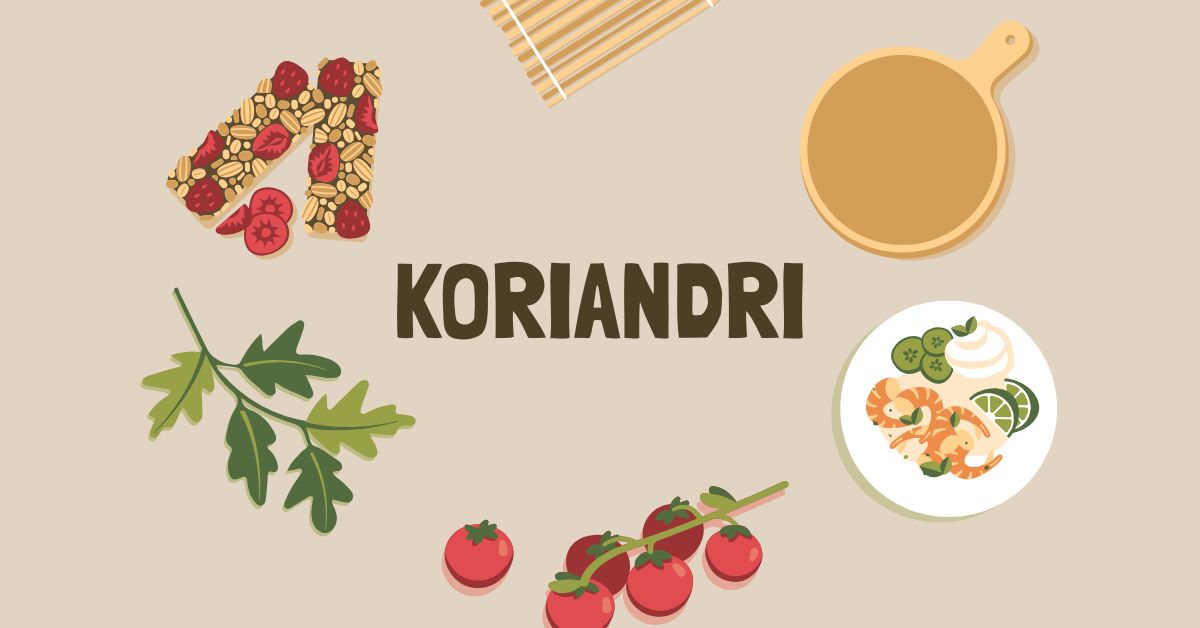Koriandri, known globally as coriander, has an ancient legacy that stretches back thousands of years. Archaeological evidence suggests that coriander seeds were used in the Mediterranean and Middle Eastern regions as early as 5000 BCE. Ancient Egyptians placed coriander seeds in tombs as a symbol of eternal love and health. Later, it spread through the spice routes to Asia and Europe, becoming a staple ingredient in many culinary traditions. The name “koriandri” is derived from the Greek word “koris,” meaning bug, due to the plant’s distinct aroma that resembles the smell of crushed bedbugs in its raw form. Despite this, once cooked or dried, its flavor transforms into a warm, citrusy essence that has captivated cultures worldwide.
Koriandri in Culinary Traditions
Koriandri plays a vital role in global cuisines, from Indian curries to Mexican salsas. In Indian cooking, coriander powder and leaves, known as “dhaniya,” add freshness and aroma to gravies, chutneys, and breads. In Middle Eastern cuisine, koriandri enhances stews and kebabs, blending beautifully with cumin and cinnamon. Latin American dishes use cilantro (fresh koriandri leaves) to balance the spice and acidity of their foods, especially in guacamole and pico de gallo. Meanwhile, European chefs use coriander seeds in baking, pickling, and sausages, bringing a unique depth to savory recipes. This universal spice bridges continents, showcasing its ability to adapt to diverse tastes and techniques.
The Distinctive Flavor Profile of Koriandri
Koriandri’s dual identity lies in its two forms — seeds and leaves — each offering distinct flavors. The seeds have a nutty, slightly citrusy profile that deepens when roasted, while the leaves, often referred to as cilantro, provide a refreshing and zesty taste. This difference allows chefs to experiment creatively in both traditional and fusion dishes. The seeds complement earthy and spicy flavors, making them ideal for spice blends, while the leaves brighten up salads, soups, and sauces. It’s this versatility that makes koriandri an essential ingredient across countless kitchens.
Health Benefits of Koriandri
Beyond its culinary allure, koriandri holds impressive medicinal value. Rich in antioxidants, vitamins A, C, and K, and essential minerals like potassium and iron, it supports immune function and promotes overall wellness. Traditional medicine systems, including Ayurveda and Chinese medicine, have long used koriandri for digestive aid, detoxification, and inflammation relief. Modern research supports these uses, showing that koriandri may lower blood sugar levels, improve heart health, and combat bacterial infections. Regular consumption of koriandri, whether in teas, powders, or raw leaves, can contribute to better digestion, clearer skin, and balanced metabolism.
Koriandri and Digestive Health
One of koriandri’s most celebrated benefits is its positive impact on digestion. Its natural compounds stimulate digestive enzymes, easing bloating, gas, and stomach discomfort. Ancient Ayurvedic texts recommend koriandri water for cooling the digestive system, especially in hot climates. Drinking water infused with crushed koriandri seeds can help relieve indigestion and nausea. Additionally, koriandri’s anti-inflammatory properties soothe the stomach lining, making it a gentle remedy for gastritis and acidity.
The Role of Koriandri in Detoxification
Koriandri is a natural detoxifier that helps the body eliminate heavy metals and toxins. Its chelating properties bind with harmful substances like lead and mercury, assisting their removal from the system. Detoxifying koriandri smoothies or juices have become popular in modern wellness trends. Combined with lemon, cucumber, and mint, koriandri provides a refreshing, cleansing boost that supports liver health and revitalizes energy levels.
Koriandri in Traditional Medicine
Ancient healers valued koriandri for more than flavor — it was a symbol of healing and protection. In Ayurveda, koriandri seeds are categorized as “tridoshic,” meaning they balance all three doshas — Vata, Pitta, and Kapha. Its cooling and calming nature helps reduce internal heat, soothe headaches, and improve sleep. Chinese herbalists used koriandri to treat measles, digestive disorders, and anxiety. Even medieval European apothecaries relied on it for its soothing aroma and medicinal potency. Today, koriandri’s holistic health benefits continue to inspire herbal remedies worldwide.
Koriandri in Modern Nutrition
As health awareness grows, koriandri has earned recognition as a superfood. Nutritionists recommend it for its detoxifying chlorophyll, antibacterial effects, and rich micronutrients. Incorporating koriandri into meals enhances both flavor and health, making it a popular ingredient in clean-eating diets. From smoothies and soups to herbal teas, koriandri brings nourishment and flavor without adding calories. For those seeking a natural boost in vitality, koriandri offers a simple yet powerful solution.
Koriandri in Global Agriculture
Koriandri cultivation spans across continents, thriving in warm, dry climates. Major producers include India, Morocco, Russia, and Mexico. The plant’s resilience makes it suitable for small farmers and large agricultural enterprises alike. Sustainable cultivation practices are increasingly being adopted, focusing on organic growth without harmful pesticides. Koriandri’s global trade continues to grow due to its rising demand in health foods, cosmetics, and pharmaceuticals.
Koriandri’s Role in Aromatherapy and Skincare
Koriandri’s essential oil, extracted from its seeds, offers a range of aromatherapeutic and skincare benefits. The oil’s soothing scent helps relieve stress and anxiety, while its antibacterial qualities make it valuable in natural skincare products. Koriandri oil can cleanse pores, balance oily skin, and improve complexion. In massage therapy, it aids relaxation and eases muscle tension. With its natural fragrance and therapeutic value, koriandri oil is becoming a popular choice in holistic beauty routines.
Koriandri in the Cosmetic Industry
Beyond the kitchen, koriandri’s essential components are used in perfumes, soaps, and lotions. Its fresh, spicy-citrus aroma adds sophistication to high-end cosmetic formulations. Cosmetic chemists appreciate koriandri for its ability to blend with other botanical extracts, creating soothing and aromatic personal care products. As consumers shift toward natural ingredients, koriandri has gained prominence as an eco-friendly and skin-safe alternative to synthetic fragrances.
Koriandri in Home Remedies
Many households still use koriandri as a go-to home remedy. A paste of coriander leaves can soothe skin irritation, while coriander seed tea helps fight colds and improve sleep. Some cultures mix coriander powder with honey to treat coughs and throat infections. Koriandri water, when consumed regularly, helps maintain hydration and cleanse the system. These traditional remedies, passed down through generations, continue to prove their worth in modern natural wellness practices.
Environmental and Cultural Significance of Koriandri
Koriandri represents more than flavor — it symbolizes connection. Across cultures, it links communities through shared culinary traditions and ancient healing practices. Environmentally, koriandri supports biodiversity by attracting pollinators like bees and butterflies. Its minimal water needs and adaptability make it a sustainable crop that fits into eco-conscious agriculture. Koriandri reminds us that nature’s simplest gifts often hold the deepest meaning, bridging heritage and health.
Future of Koriandri in Global Trends
As sustainability, health, and flavor continue to define future food trends, koriandri’s global influence will only grow. It aligns perfectly with the demand for plant-based, clean, and organic ingredients. From gourmet restaurants to wellness industries, koriandri is celebrated for its ability to blend traditional wisdom with modern science. Future innovations may include koriandri-based supplements, skincare lines, and functional foods that maximize its medicinal potential.
Conclusion
Koriandri is not just an herb — it’s a symbol of harmony between flavor, health, and culture. From ancient temples to modern kitchens, it has remained a trusted ally in enhancing life’s essence. Whether you sprinkle it over food, brew it into tea, or use it for self-care, koriandri’s versatility and benefits make it truly timeless. As the world rediscovers the value of natural wellness, koriandri stands as a fragrant bridge between past wisdom and future well-being.
FAQs
What is the difference between coriander and kori’andri?
Koriandri is another name for coriander, derived from its traditional linguistic roots. Both refer to the same plant species, Coriandrum sativum.
Can koriandri help with weight loss?
Yes, kori’andri aids digestion and boosts metabolism, making it an effective natural support for weight management when combined with a balanced diet.
Is koriandri safe for daily use?
Absolutely. Both coriander seeds and leaves can be consumed daily, offering nutritional and medicinal benefits without side effects when used moderately.
How can I use kori’andri for skincare?
Koriandri oil or paste can help reduce acne, cleanse pores, and brighten skin when used in natural face masks or diluted oils.
What’s the best way to store koriandri seeds and leaves?
Store dried seeds in an airtight container away from moisture, and keep fresh leaves refrigerated in a damp cloth to maintain freshness longer.












